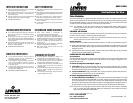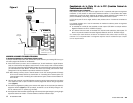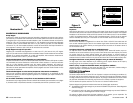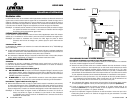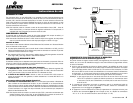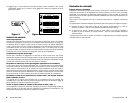
TROUBLESHOOTING:
No picture...
Verify that the video source is on and is producing a video signal. Check that the TV and the modulator are
tuned to the same channel, also check all F-connections for bent or broken center conductors. The modulator
broadcasts on UHF for channels 14-69, and CATV for channels 70-125. Make sure the TV is set to ANTENNA,
or UHF if the modulated channel is 14-69, and CATV if modulated channel is 70-125. Do not use channels
95-99 for modulated input. See your TV instructions for more information about UHF and CATV settings.
No picture through cable box...
Be sure that the modulator is programmed for a channel from 70-94 or 100-125. Some cable boxes will
move or block modulated signals. Check for the modulator signal several channels above and below the
selected channel. If the signal is blocked, you must bypass the box and switch the TV between channel 3
and the modulator channel.
Herringbone interference or diagonal lines on modulated channel...
You may have chosen a channel number that is not completely vacant. Distant UHF stations may be un-
watchable, but still cause interference if you try to create a new channel at the same frequency. The channel
you choose should be an unused channel between two unused channels, to minimize chances of
interference. Sometimes cable companies have extra signals where there appear to be none. Try moving the
modulator channel to another number. You may have to add a Notch Filter to remove cable company noise.
Herringbone interference on many channels (disappears when you remove the Modulator)...
The high output of the Leviton Modulator may be overdriving your RF amplifier. Reduce the RF output by
lowering the gain on the modulator (see page 2 for more information).
Weak or “snowy” reception on modulated channel, once signals are combined...
Increase RF output of modulator for best picture (see page 2 for more information). Consider adding an
amplifier, attenuator or tilt compensator to boost and balance signal.
FCC Part 15 Compliance
Installation Requirements
This device complies with Part 15 of the FCC rules. Operation is subject to the following two conditions: (1)
This device may not cause harmful interference, and (2) This device must accept any interference received,
including interference that may cause undesired operation. Any change or modification to this device without
the permission of NetMedia and Leviton Mfg. may void the user’s authority to operate this equipment.
The FCC classifies this product under Part 15 of its rules as a “television interface device”.
Systems designed using television interface devices have the following legal requirements:
1. The modulated channel signal strength may not exceed 15.56dBmV at any television. Federal Regulation
47CFR15.115(b)(l)(i).
2. If an antenna is used in the system, the modulated channel signal strength may not exceed -51dBmV at
the antenna input port. Federal Regulation 47CFR15.115(c)(4).
The system you design must comply with these regulations. As the installer, you are responsible. The
accompanying diagram illustrates an installation that ensures compliance.
1
2
345
67
8
O
N
Example: UHF Channel 48
OFF
ON
SUM
ZO
+
-
Gain
12
48
10
204080
Example: CABLE Channel 117
OFF
ON
SUM
ZO
+
-
Gain
12
48
10
204080
Example: CABLE Channel 120
OFF
ON
SUM
ZO
+
-
Gain
12
48
10
204080
Figure 2
Figure 3
DI-030-48213-20B 3
10 DI-030-48213-20B
DIAGNÓSTICO DE ANORMALIDADES
No hay imagen...
Verifique que la fuente de suministro de video esté encendida y produciendo una señal de video. Confirme
que el televisor y el modulador estén sintonizados al mismo canal, también revise todas las conexiones tipo
F y asegúrese que no hay conductores centrales doblados o rotos. El modulador transmite en UHF para los
canales 14 – 69, y por TV por cable para los canales 70 – 125. Asegúrese que el televisor esté programado
en ANTENA o UHF si el canal modulado está entre el 14 y 69, y CATV (TV por cable) si el canal modulado
está entre el 70 y 125. Para entradas moduladas, no utilice los canales 95-99. Para mayor información en
como programar su televisor a UHF o CATV, lea las instrucciones de su televisor.
No hay imagen en la caja de TV por cable…
Asegúrese que el modulador esté programado a un canal entre el 70 y 94 ó entre el 100 y 125. Algunas
cajas de TV por cable mueven o bloquean señales moduladas. Busque la señal modulada en varios canales
alrededor de los canales seleccionados. Si la señal está bloqueada, debe conectarse directamente al
televisor y sintonícelo entre el canal 3 y el canal modulado.
Interferencia Herringbone o líneas diagonales en el canal modulado…
Es posible seleccionar un canal que no está completamente disponible. Estaciones UHF lejanas no pueden
ser sintonizadas pero causan interferencia si intenta utilizar la misma frecuencia. El canal que seleccione
debe ser un canal disponible localizado entre dos canales también disponibles, para reducir las
posibilidades de encontrar interferencia. En algunos casos, las compañías de TV por cable poseen señales
adicionales en canales aparentemente disponibles. Pruebe programar otro canal. Puede necesitar un filtro
para combatir la interferencia.
Interferencia Herringbone en varios canales (desaparecen al desconectar el modulador)…
Puede ser que la poderosa salida del Modulador Leviton esté interfiriendo con su amplificador de radio
frecuencia (RF). Reduzca la salida RF, bajando la ganancia en el modulador (para mayor información, lea
nuevamente la página 9).
Con las señales combinadas, la recepción en el canal modulado es débil o nublosa…
Para obtener la mejor imagen posible, aumente la salida RF del modulador (para mas detalles,vea la página
9). Considere añadir un amplificador, atenuador, o compensador para aumentar y balancear la señal.
1
2
345
67
8
O
N
Ejemplo: Canal 48 de UHF
OFF
ON
SUM
Z
O
+
-
Gain
12
48
10
204080
Ejemplo: Canal 117 de TV por Cable
OFF
ON
SUM
Z
O
+
-
Gain
12
48
10
204080
Ejemplo: Canal 120 de TV por Cable
OFF
ON
SUM
Z
O
+
-
Gain
12
48
10
204080
Ilustración 2
Ilustración 3



